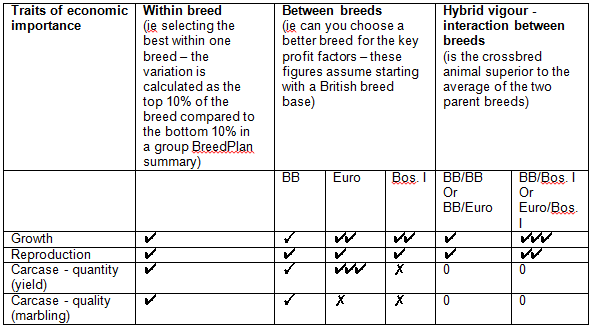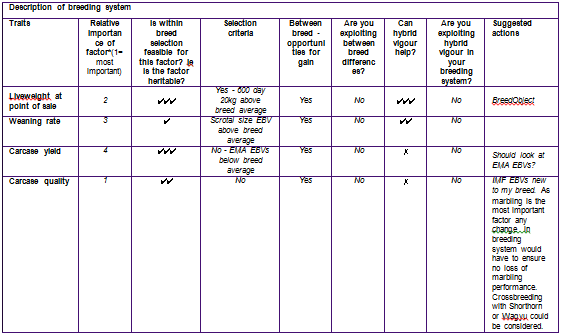4.02 - Breed trait averages
Some progress has been made to compile well designed lookup tables that allow a reasonably reliable comparison of differences between breeds. However, they are not currently available for the full set of breeds and traits that impact on enterprise profit.
When designing a crossbreeding program, it may be wise to seek professional help. There is a course, developed by MLA, specifically for designing breeding programs. This includes a major section on crossbreeding that could provide valuable assistance with the design of a crossbreeding program. The course is entitled More Beef from Breeding and is designed to support More Beef from Pastures clients who need to study beef breeding in more detail.
The following tables are extracted from the More Beef from Breeding course material.
How breeding systems can exploit genetics
Table 1: Sources of genetic differences

-
✔ represents approximately 5% gain
-
✓ represents approximately 2.5% gain
-
✗ represents a 5% loss in desired trait
-
0 represents no gain
Source: MLA More Beef from Breeding Workshop Notes
Table 2: Potential to change key factors for a southern production system tailored to a longfed export market

Open PDF
*Indexing programs such as BreedObject, assist to determine the relative importance of traits more accurately.
Multibreed EBVs
The first multibreed EBVs were released last year for four breed groups (Angus, Poll Hereford, Limousin and Simmental). This means that for the first time we can compare bulls and females directly across these breeds, whereas previously, it was only possible to compare the EBVs within breeds. At this stage it is possible to do this for gestation length, liveweights up to 600 days and carcase weight.
Table 3 presents the adjustment factors that need to be used to make direct comparisons possible across the four breeds.
Table 3: Multibreed EBV adjustment table (March 2003)
| Gestation length | Birth weight | 200-day weight | 400-day weight | 600-day weight | Carcase weight | |
| Angus | 0.0 | 0.0 | 0 | 0 | 0 | 0 |
| Poll Hereford | 1.1 | 2.8 | 9 | 21 | 16 | 8 |
| Limousin | 9.2 | 6.4 | 13 | 25 | 17 | 20 |
| Simmental | 6.4 | 8.7 | 31 | 63 | 71 | – |
Table 3 provides estimates of the genetic differences between these breeds for the traits mentioned, using Angus as the baseline.
All that is needed to produce multibreed EBVs for a given trait, is to add to an animal’s existing within breed EBV the value listed in Table 3 for that breed. For example, to compare an Angus bull with an EBV for carcase weight of +33, with a Limousin bull that has a within breed EBV of +16, we have:
Angus bull with a value of 0 [from Table 3]+ 33 = 33
Limousin bull with a value of 20 [from Table 3]+ 16 = 36
So for the two bulls in this example the Limousin bull has an advantage of + 3 for this trait.
Further information
Research institutes where the most useful breed comparisons have been conducted are listed below. Each organisation has publications summarising and presenting the results. When reviewing any breed comparison data, consider how recently the studies have been conducted. Some breeds have made rapid progress, particularly for growth traits, over the last two decades.
- Beef CRC (2005–2012) legacy website at www.beefcrc.com – look for papers by Binden et al.
- US Department of Agriculture Clay Centre, Nebraska at www.usda.gov - look for papers by Cundiff et al.
Note: The USDA Clay Centre work in Nebraska is by far the most comprehensive, but has been conducted under North American conditions of environment, feeding and markets.
- State departments of primary industries and agriculture also provide useful resources:
- New South Wales Department of Primary Industries: www.dpi.nsw.gov.au – look for papers by Hearnshaw et al.
- Department of Primary Industries, Victoria: www.dpi.vic.gov.au – look for papers by Morgan, Graham et al.
- Department of Primary Industries and Regions, South Australia: www.pir.sa.gov.au – look for papers by Deland et al.
- Department of Agriculture and Food, Western Australia: www.agric.wa.gov.au
- Department of Primary Industries, Parks, Water and Environment, Tasmania:
- www.dpiwe.tas.gov.au
